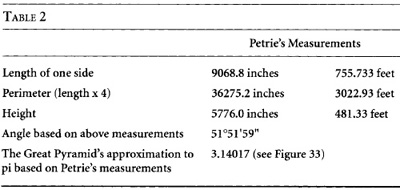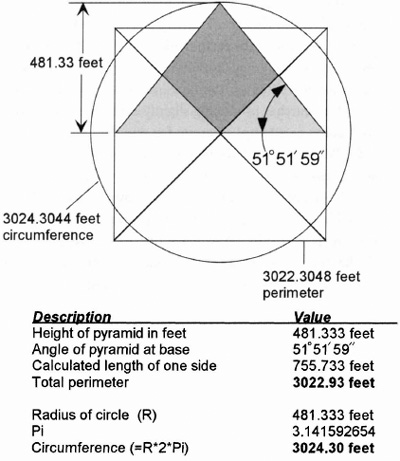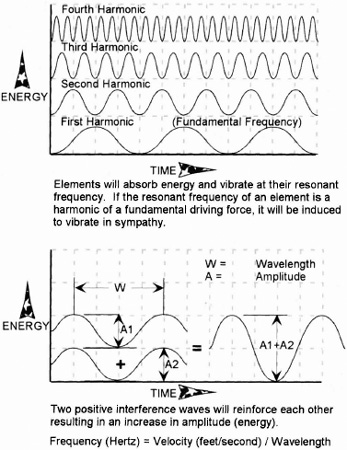The Giza Power Plant (20 page)
F
IGURE
32.
Center of Earth's Landmass
It was the discovery of the knowledge of the transcendental number of pi (Ï) in the Great Pyramid that prompted Taylor to conclude that the perimeter of the Great Pyramid could be analogous to the circumference of the Earth at the equator. The height would represent the distance from the center of the Earth to the poles. Further studies of the dimensions of the Great Pyramid revealed surprising inferences regarding the knowledge of its builders. When searching for a unit that would fit the pyramid in whole numbers yet still retain the pi proportion, Taylor's answer of 366 base and 116.5 height suggested to him that the Egyptians may have divided the perimeter of the Great Pyramid into segments of the solar year. He also found the figure 366 when he divided the base of the pyramid by 25 inches. This suggested that the British inch was close to the Egyptian unit of measure, with 25 such units making one cubit.
It was later concluded that the Egyptian unit of measurement exceeded that British inch by .0011 inch, and Taylor found that this unit fit the Great Pyramid in multiples of 366. Even more astounding, geodetic research of the Earth established the Egyptian inch as an accurate unit of the dimensions of the polar radius. Peter Tompkins, in
Secrets of the Great Pyramid,
wrote: "To Taylor the inference was clear: the ancient Egyptians must have had a system of measurements based on the true spherical dimensions of the planet, which used a unit which was within a thousandth part of being equal to a British
inch."
4
It was speculated that the British inch has lost a thousandth part after many generations of use.
Piazzi Smyth was a supporter of John Taylor and communicated with him frequently. Following Taylor's death in 1864, Smyth was able to confirm his calculations and also his correlation between the Great Pyramid and the Earth: ". . . and there appears to be further an even commensurability of a most marvelous order, between the weight of the whole Great Pyramid and
the weight of our planet earth.
The Great Pyramid itself, found to be Harmoniously Commensurable with the Earth, by Weight of the
whole."
5
Smyth calculated the weight of the Great Pyramid to be 5,273,834 pyramid tons and the weight of the Earth to be 5,273,000,000,000,000,000,000 pyramid tons. As such, he calculated it to be
a 10
15
integer of the Earth's weight.
6
To review Taylor's findings:
- A pyramid inch is .001 inch larger than a British inch. There are 25 pyramid inches in a cubit and there were 365.24 cubits in the square base of the Great Pyramid.
- There are 365.24 days in a calendar year.
- One pyramid inch is equal in length to 1/500 millionth of the Earth's axis of rotation. This relationship suggests that not only were the builders of the Great Pyramid knowledgeable of the dimensions of the planet, they based their measurement system on them.
What else is unique about the Great Pyramid? Although it is a pyramid in shape, its geometry possesses an astounding approximation to the unique properties of a circle, or sphere. The pyramid's height is in relationship with the perimeter of its base as the radius of a circle is in relationship with its circumference. A perfectly constructed pyramid with an exact angle of 51°51' 14.3" has the value pi incorporated into its shape (see Table 2).
Pi (3.1415926) is an incommensurable number that, before calculators were invented, engineers used to round off to a three-or four-place decimal. It is startling to read, therefore, that in 1883 Petrie published his painstaking measurements of the Great Pyramid and recorded the following: "On the whole, we probably cannot do better than take 51°52' ± 2' as the nearest approximation to the mean angle of the Pyramid, allowing some weight to the South side. The mean base being 9068.8 ± .5 inches, this yields a height of 5776.0 ± 7.0
inches."
7


FIGURE 33.
The Pi Factor
William Fix presented well-founded and objective data to support this claim: "We know that someone in very deep antiquity was aware of the size and shape of the earth with great precision. The three key measurements of the earth are incorporated in the dimensions of the Great Pyramid. The perimeter of the Pyramid equals a half minute of equatorial latitude. The
perimeter of the sockets equals a half minute of equatorial longitude, or 1/43,200 of the earth's circumference. The height of the Pyramid including the platform, equals 1/43,200 of the earth's polar radius.... We do not know how they measured it, but that they did so is now an article of
knowledge."
8
There are volumes written on the measurements taken of the Great Pyramid, with each researcher producing slightly different results than the others. I am not going to attempt to argue for one data set or the other; however, I prefer Petrie's more realistic and "real-world" approach in reporting his data in that he provides a tolerance band within which his measurement may fall. Within the tolerance band he gave for the angle of the pyramid, we could have taken the perfect pi proportion, but it really is not necessary for the purposes of this book. What I have established by providing this data is that there is a distinct relationship between the Great Pyramid and the Earth. This is evidenced by the measurements of the pyramid and by its location.
When we question
why
there is a correlation between the Earth's dimensions and the Great Pyramid, we come up with three logical alternatives. One is that the builders wished to demonstrate their knowledge of the dimensions of the planet. They felt it necessary to encapsulate this knowledge in an indestructible structure so that future generations, thousands of years in the future, would know of their presence in the world and their knowledge of it.
The second possible answer could be that the Earth affected the function of the Great Pyramid. By incorporating the same basic measurements in the pyramid that were found on the planet, the efficiency of the pyramid was improved and, in effect, it could be a harmonic integer of the planet.
A third alternative may involve both the first and the second answers. The dimensions incorporated in the Great Pyramid may have been included to demonstrate the builders' knowledge or more importantly, to symbolize the relationship between the Great Pyramid's true purpose and the Earth itself. Perhaps the dimensions were not a critical requirement for the function of the pyramid, but were included to satisfy the aesthetic nature of the builders.
Considering the degree of practical consciousness evident in the Great Pyramid, I am inclined to accept a practical answer for noted phenomena
and choose the second alternative because it recognizes a level of pragmatism that such a degree of consciousness would undoubtedly possess. The second alternative leaves no doubt that the builders of the Great Pyramid did not go to a vast amount of trouble simply to pass along their knowledge to some future generation. They used their energies for a more self-serving and timely purpose. That the builders of the Great Pyramid employed the dimensions of the Earth in their pyramid as a means to an end in achieving a specific result is easier to accept than the speculation that it was the result of some magnanimous gesture intended for future generations. Could our society afford to buildâif we were able toâsuch a structure for this purpose?
Having established the relationship between the Great Pyramid and the Earth, it would be helpful if we remind ourselves that the measurements of an object are not the object itself but a means to create the objectâor a means to an end. With the Great Pyramid the means are clearly evident. To what end they were used will become more obvious as we move along.
We know that the Earth is a vibrating dynamic body with tremendous forces that build up over time, forces that eventually result in a sudden release of a tremendous amount of energy. We might ask, therefore, "How can we tap into that energy?" Is there a way to draw the energy off over a period of time, thereby decreasing its intensity and possibly precluding the destructive forces of an earthquake? Science has shown us that it is possible, on a much smaller scale, for an object to draw mechanical energy from another vibrating object if both their vibrating frequencies are in harmony. But to draw mechanical energy out of the Earth would be a huge task. What would the requirements be for the object that we would use to accomplish such a thing?
Before we can answer these questions, we must refresh our minds regarding
resonance
and
harmonics,
for these are the natural phenomena that we would need to work with to accomplish such a task (see Figure 34). Resonance is the sympathetic vibration of one object with another. A piano provides a simple example of resonance. Press down one key, or several keys forming a chord, without actually striking the note, and then undamp the strings by pressing the loud pedal. Play the corresponding notes an octave higher, and the strings you have open on the lower octave will vibrate in sympathy. Hum into the piano in the same pitch and the strings will again respond. This
transfer of energy is due to resonance. The transmission of energy and vibration go hand in hand. The strings of a musical instrument are induced to vibrate, and the energy reaches our ears in the form of sound waves.
When airborne sound forces mechanical vibrations in several piano strings that vibrate at different frequencies, the phenomenon known as harmonics is at work. Elements (strings) will absorb energy from a source more efficiently if they are of the same frequency. Multiples of the fundamental forcing frequency, known as harmonic frequencies, also will efficiently absorb this energy and vibrate at their natural resonance.
Resonance can probably best be described by a classic example of how this natural phenomenon can unleash an awesome and destructive power.
This incident occurred on the morning of November 7,1940, in the State of Washington. The Tacoma Narrows Bridge created a link between the Olympic Peninsula and the mainland. It had been open only for four months when tragedy struck. In gusts of wind at only forty-two miles per hour, the bridge began to oscillate, wildly swaying back and forth. The gusts of wind swept across the bridge at a frequency that matched the bridge's natural resonant frequency. As the gusts of wind continued, the bridge's torsional vibrations amplified to the point that the suspenders were torn away from their moorings and the bridge began to break up. Fortunately, it was closed to traffic in time, and no lives were lost. Nature's demolition of the Tacoma Narrows Bridge is given as a classic example of the destructive forces that can be induced in a structure that is subject to periodic influxes of energy. In this case, the energy was provided by the wind, which swept the bridge at the appropriate resonating frequency of the structure. With insufficient restraint, or damping, any vibrating structure may eventually be destroyed, as long as it is drawing energy from the source.

F
IGURE
34.
Resonance and Harmonics
Another example of the potentially destructive force of resonance, and the measure taken to prevent it, is the instruction for soldiers to break step when marching across a bridge. Each step of an individual soldier acts as a force on the bridge. If the rest of the company joins this soldier in marching in unison across the bridge, the energy provided by that one step is amplified many times over, and the bridge will vibrate in time to the march. The pounding foot on the bridge is known as the forcing frequency. If the frequency of the marching feet happens to coincide with the natural frequency at which the bridge resonates, the absorption of energy will be maximized and the vibration of the bridge will become much greater, and it could potentially cause the bridge to collapse.

